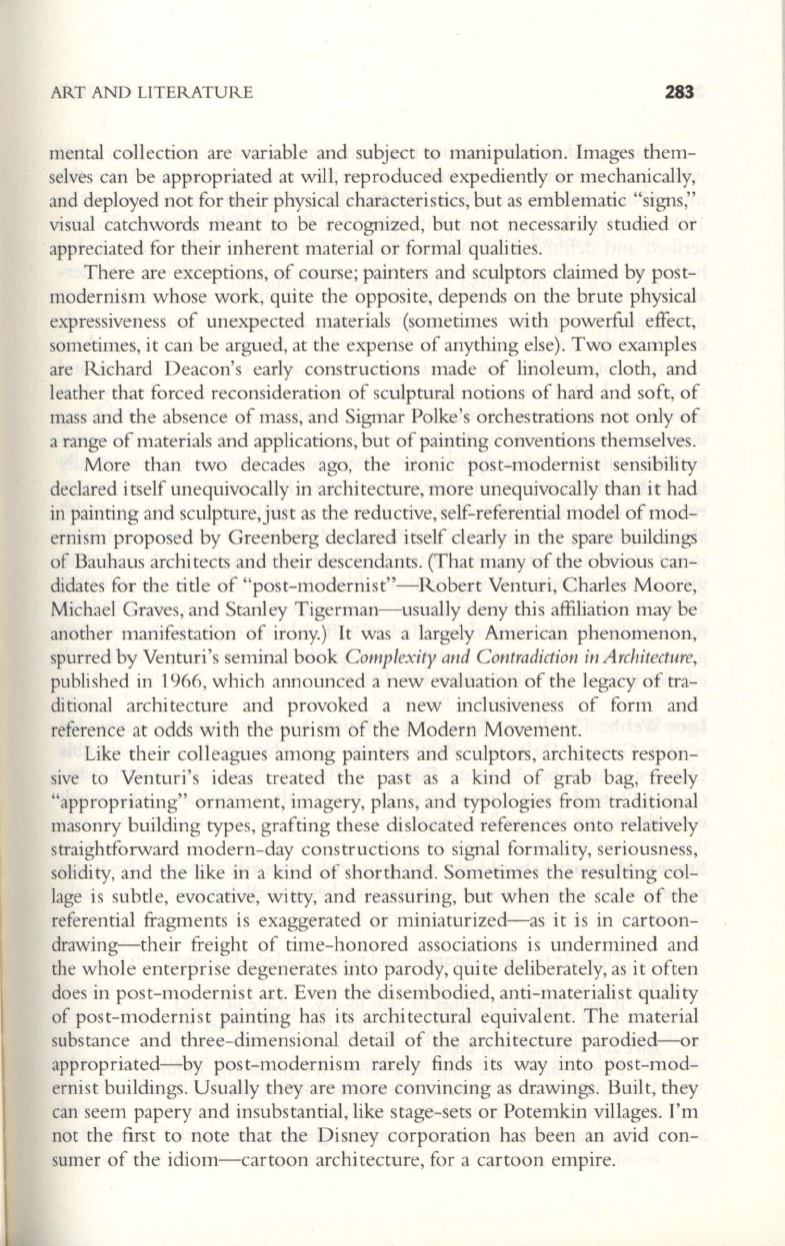
ART AND LITERATURE
283
mental collection are variable and subject to manipulation. Images them–
selves can be appropriated at will, reproduced expediently or mechanically,
and deployed not for their physical characteristics, but as emblematic "signs,"
visual catchwords meant to be recognized, but not necessarily studied or
appreciated for their inherent material or formal qualities.
There are exceptions, of course; painters and sculptors claimed by post–
modernism whose work, quite the opposite, depends on the brute physical
expressiveness of unexpected materials (sometimes with powerful effect,
sometimes, it can be argued, at the expense of anything else). Two examples
are Richard Deacon's early constructions made of linoleum, cloth, and
leather that forced reconsideration of sculptural notions of hard and soft, of
mass and the absence of mass, and Sigmar Polke's orchestrations not only of
a range of materials and applications, but of painting conventions themselves.
More than two decades ago, the ironic post-modernist sensibility
declared itself unequivocally in architecture, more unequivocally than it had
in painting and sculpture, just as the reductive, self-referential model of mod–
ernism proposed by Greenberg declared itself clearly in the spare buildings
of Bauhaus archi tects and their descendants. (That many of the obvious can–
didates for the title of "post-modernist"-Robert Venturi, Charles Moore,
Michael Graves, and Stanley Tigerman-usually deny this affiliation may be
another manifestation of irony.) It was a largely American phenomenon,
spurred by Venturi's seminal book
Complexity and Contradiction in Architecture,
published in 1966, which announced a new evaluation of the legacy of tra–
ditional architecture and provoked a new inclusiveness of form and
reference at odds with the purism of the Modern Movement.
Like their colleagues among painters and sculptors, architects respon–
sive to Venturi's ideas treated the past as a kind of grab bag, freely
"appropriating" ornament, imagery, plans, and typologies from tradi tional
masonry building types, grafting these dislocated references onto relatively
straightforward modern-day constructions to signal formality, seriousness,
solidity, and the like in a kind of shorthand. Sometimes the resulting col–
lage is subtle, evocative, wi tty, and reassuring, but when the scale of the
referential fragments is exaggerated or miniaturized-as it is in cartoon–
drawing-their freight of time-honored associations is undermined and
the whole enterprise degenerates into parody, quite deliberately, as it often
does in post-modernist art. Even the disembodied, anti-materialist quality
of post-modernist painting has its architectural equivalent. The material
substance and three-dimensional detail of the architecture parodied-or
appropriated-by post-modernism rarely finds its way into post-mod–
ernist buildings. Usually they are more convincing as drawings. Built, they
can seem papery and insubstantial, like stage-sets or Potemkin villages. I'm
not the first to note that the Disney corporation has been an avid con–
sumer of the idiom-cartoon archi tecture, for a cartoon empire.


